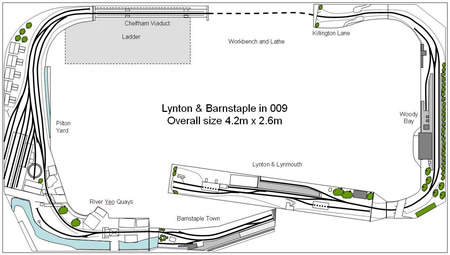|
|
Pilton Yard in 009
by Bob Barnard


Construction of my model of Pilton Yard
took place around 1980, but it was stored for several years before being
included in a larger L&B layout in my loft in the mid 1990s. At this time
it was integrated with the River Yeo Quays section to form a continuous
L-shaped scenic section. The scenery and structures at Pilton were
refurbished and detailed in 2005.
The track plan is the same as the original, although the size is
compressed somewhat.
Track is proprietary 009, with pointwork hand made to suit each situation.
The controlled points are operated by slow-acting mechanisms, whilst the
yard points are operated by individual switches and rodding under the
baseboard. Dummy point rodding of the correct round type has been added to
the layout for the sake of appearance.
The lattice semaphore signals at Pilton are built from MSE components, and
operated by modified Maplin power relays. Clearance of the signals is
dependent on correct point detection, but Pilton does not yet have full
interlocking between points and signals, and is operated from an interim
switch panel. Lever numbers are pure guesses on my part, as the original
numbering is not known; when I build the final lever frame I will renumber
the points and signals in a more likely sequence, based on continuing
research by L&B experts. Entry to the single line sections is controlled
by my “Tokenless Block” system.
Buildings and scenic items are built from
scratch using some 00 scale kits and components. The sheds are constructed
from thin ply and stripwood, covered with the appropriate embossed plastic
sheeting.

Pilton Bridge signal box is constructed using
parts from a Ratio plastic kit, and contains a dummy lever frame and Tyers
block instruments.

Although there are no photographs of the
L&B’s turntable being used to turn vehicles, the model can be operated by
hand, if required – but there is no point, as the chopper couplings are
all single-ended! The terrace of houses backing on to the yard is an
imaginative representation of the original, using card kits to save time
in construction. At the front of the layout, a mill race flows, carrying
water from the River Yeo upstream to Baker’s Mill on Braunton Road. Near
Pilton level crossing, the line squeezes between the earlier buildings
originally occupied by a fellmonger – the offices became the L&B HQ until
1935, but the yards remain in the foreground of the layout.

L&B, and provided workshop facilities, as
well as sheds for locomotives and carriages. The goods yard dealt with the
general freight carried on the line. The line ran ”mixed” trains
throughout its life, with goods vehicles added to many passenger trains.
The trains were usually assembled at Pilton, and propelled through the
town, over the two level crossings, ready to meet passengers arriving from
main line trains on the Southern Railway’s Ilfracombe line at Barnstaple
Town. It was also necessary to shunt wagons from Pilton to the quay siding
and the transhipment siding at Town, for example to load with coal and
other bulky supplies for Lynton.
There are plenty of photos of the original Pilton Yard, from most angles,
so research for this section was quite straightforward.
My L&B models have been described in the L&B Magazine, and some have been
exhibited at the restored Woody Bay, and at Model Railway Exhibitions in
the Lancashire and Cheshire, as part of the L&B North West Area Group
display and sales stand, which promotes interest in the L&B in the region.


Bob Barnard
barnard.bob@btinternet.com
 |